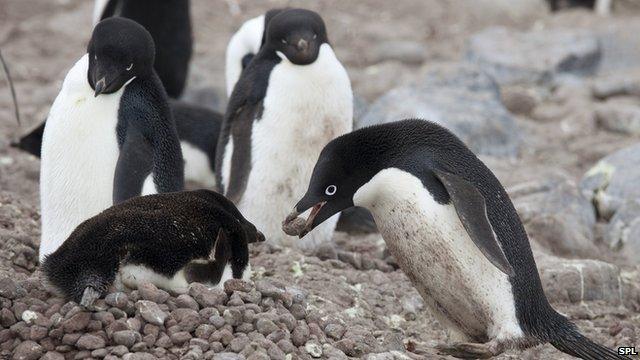Colder climate holds key to fluctuations in penguin numbers
- Published

Adélie penguins nesting on Antarctica
Historic fluctuations in the populations of penguins have been linked to changes in climate say scientists.
Researchers analysed ancient bird droppings to determine when penguin numbers went up or down.
The patterns weren't easily predictable but colder weather seemed to benefit birds living further south.
The study is published, external in the Journal, Nature Scientific Reports.
Adélie penguin populations in the high Antarctic were at their peak during a cold period which began in 1490.
But populations further north are thought to have declined in this period.
To find out why, researchers in China and the US took soil samples from a site at Cape Bird, on Ross Island in the high Antarctic, and analysed the biological matter. The depth the sample was taken from revealed how old the soil was.
Nesting needs
Prof Steven Emslie, from the University of North Carolina and one of the authors of the paper, told BBC News: "Adélie penguins nest on land instead of ice like the Emperor penguin, so they leave behind a record.
"And that record can be hundreds to thousands of years old depending on the preservation of the sediments and it's usually pretty good in the Antarctic. And it preserves organic remains very well."
The record he's referring to is their droppings, or guano.
Penguin guano contains cholesterol and cholestanol, and the levels of these fats in the soil samples were taken as evidence for the size of the penguin colony at that time. Other biological matter in the soil gave clues as to the levels of algae and lichen in the region at that time too.
The Little Ice Age happened in the Antarctic between 1500 and 1800 AD, when the average summer temperature was roughly 2°C colder than centuries before and after this period.
During this time, the present research found evidence that Adélie penguin numbers on Ross Island went up.
Conversely, previous research conducted at sites further north has found the opposite pattern, with Adélie penguin populations declining in these periods.
.jpg)
A map showing the location of the sampling site, and previous sites further north
The authors suggest there are reasons for the differences in penguin population fluctuations between higher and lower latitudes in the Antarctic.
As Professor Emslie stated, Adélie penguins need land to build their nests on. A slightly warmer Antarctic climate allows more snow to fall, which means the penguins have to wait until later in the summer to build their nests, once the snow has melted.
However, there are some negative consequences of a colder climate. The authors mention more sea ice during colder periods, meaning the penguins have to travel further to find food. But, algae grow on the underside of sea ice. Algae are a food source for krill, which themselves are a food source for penguins.
The authors note that wind also increased during the Little Ice Age, in the area they took their samples from. This wind has been known to cause the ice to crack, creating areas of open water, which can make it easier for penguins to hunt.
Lessons for today
This, the authors suggest, could possibly explain why penguin populations fell further north, but went up in this region.
Prof Emslie said: "It's really complex what controls penguin populations either increasing or decreasing in the Antarctic. It's not as simple as climate change and global warming is causing a decline."
He also discussed how these results impact on our understanding of penguin populations at the moment. Penguin populations are currently declining in some areas, but remaining steady in others: "The implication is that we have to take any general trends that we're seeing in the Antarctic today with warming trends, and we have to apply our knowledge on how complex the situation is.
"In 2010 when I was at Cape Bird, there was a lot of meltwater coming down through the colony that didn't used to occur. It was affecting the nests because the nests were getting inundated with meltwater coming down from the glacier, and that's definitely going to affect the breeding success of the nests that are in that area. So that might be the start of a negative period now as the warming trend continues to increase. But we don't have the data yet to show that, so that's just observation right now."
- Published21 May 2013
- Published16 July 2013
- Published1 May 2013